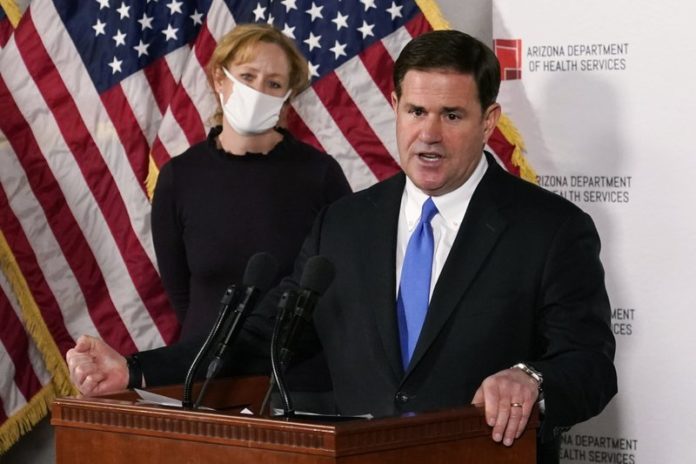
Some Arizona hospitals have stopped accepting patients brought to them by ambulance runs and transfers, as they scramble to address a backlog of sick people amid a COVID-19 surge, the state’s largest hospital chain, said Tuesday.
Banner Health said 10 hospitals were diverting ambulances and transfers to other medical facilities late Monday and six were still doing so early Tuesday. All hospitals continued to accept walk-in patients needing emergency care.
Arizona is grappling with the second-highest coronavirus infection rate in the nation. California has the highest.
Moving to keep hospitals from getting further overwhelmed, state officials announced Tuesday that Arizona will include people aged 75 and older — over 534,000 residents — in the second phase of COVID-19 vaccinations. Older adults are more likely to be hospitalized with severe complications from the disease and fill ICU beds.
Prioritizing people 75 and older “will keep a lot of vulnerable people from getting sick,” noted Will Humble, Arizona Public Health Association director and a former state health services director.
Humble said diverting ambulances and patient transfers is not unusual during Arizona’s winter months when they are more full due to the flu, but he had never seen more than a couple hospitals undertake the measure at the same time.
“The patients will still get care, they’ll just go to a different hospital,” he said, adding that 911 emergency operators help get ambulances to hospitals equipped to deal with more patients. “But if you look at the trajectory, you can see we’ve been headed toward a crisis.”
Banner Health said Tuesday in a tweet that the unusually high number of hospitals diverting ambulances or transfers of new patients was accompanied by “the length of stay and complexity of care for COVID-19 patients adding to the challenge.”
On Tuesday, Arizona reported 2,799 additional known COVID-19 cases and a near-record 171 deaths, of which 148 were a result of periodic death certificates. Arizona’s totals since the pandemic began rose to 507,222 cases and 8,640 deaths.
The state’s coronavirus dashboard reported that 4,475 people were hospitalized for COVID-19 as of Monday, the latest in several records reported since early December. COVID-19 hospitalizations during the summer surge peaked at 3,517 on July 30.
COVID-19 patients occupied 53% of all inpatient beds and 59% of intensive care beds.
Prioritizing people 75 and older ensures those most at risk are vaccinated sooner, protecting them and “relieving the strain on our hardworking health care professionals,” Gov. Doug Ducey said in the statement.
Ducey and the Arizona Department of Health Services said the decision to prioritize people 75 and older was made Monday by a state committee of experts working with updated recommendations from the federal Centers for Disease Control and Prevention.
Vaccinations have already begun for the first phase of prioritized groups, including frontline health care providers, emergency medical service workers, and residents and staff of long-term care facilities.
Others to be prioritized in the second phase include teachers, child care providers, law enforcement personnel, and corrections workers. The state anticipates those vaccinations will begin statewide by late January but some counties may begin earlier, the statement said.
The state’s seven-day rolling average of COVID-19 deaths has increased over the past two weeks from 58.3 on Dec. 14 to 71 on Monday while the rolling average of daily new cases dropped from 7,772 to 6,154, according to data from Johns Hopkins University and The COVID Tracking Project.
The number of infections is thought to be far higher than reported because many people have not been tested, and studies suggest people can be infected with the virus without feeling sick.
Republished with the permission of the Associated Press.














